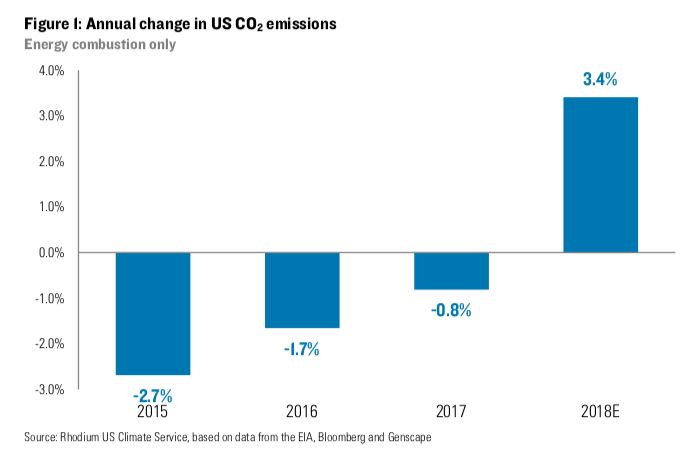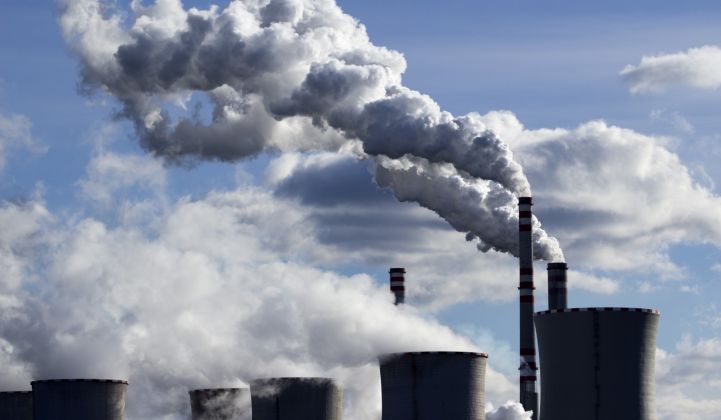Energy-related emissions increased last year at a rate the U.S. hasn’t experienced since 2010, according to an analysis Rhodium Group released Tuesday.
The climb in energy-related carbon dioxide emissions in 2018 rivaled the 3.6 percent increase in 2010 — a rebound after the Great Recession. According to the research group’s analysis, the 3.4 percent increase in 2018 is the nation's second-highest emissions increase in two decades.
Last year was also the first time in recent years that any measurable level of emissions increase was recorded.

The news comes on the heels of research that found global carbon dioxide emissions are increasing at a rate akin to a “speeding freight train.” Rhodium’s research affirms what other scientists claimed in several 2018 reports: Rising manmade emissions are creating an increasingly tricky climate conundrum.
According to Rhodium, U.S. emissions declined 12.1 percent between 2007 and 2015. The economic woes that spurred the Great Recession helped bring about much of that decline — emissions tend to rise and fall in line with the economy (although the world has seen some measure of decoupling in recent years). A switch from coal to natural gas and renewables helped too.
But since 2016, the pace of emissions declines has slowed.
John Larsen, head of U.S. power sector and energy systems research at Rhodium, attributes the slowdown to “broader macroeconomic factors,” rather than changes in federal policy. In 2018, economic growth reached new heights, low oil prices made driving more enticing, and buildings consumed more energy for uses such as heating and cooking.
Those drivers pushed energy-related emissions up in spite of a noteworthy year for coal retirements.
Various research outlets forecasted that 2018 would bring a high tide of coal plant closures. The Institute for Energy Economics and Financial Analysis, for instance, suggested that the U.S. would retire 15.4 gigawatts of capacity and best the previous record set by the 14.7 gigawatts that closed in 2015. In December, the U.S. Energy Information Administration estimated that 2018 would come in just under the record, at 14 gigawatts shut down. At the same time, EIA said that coal consumption in 2018 would be at its lowest levels since 1979.
But those retirements on their own are not enough to draw down energy-related emissions, according to Rhodium’s results.

Because much of that coal capacity was replaced with natural gas, and U.S. power use increased “meaningfully” in 2018, power sector emissions grew by 1.9 percent. There’s more natural-gas infrastructure slated for construction, and there are more reserves in the ground.
“Gas is well-suited to meet any increase in demand readily,” said Larsen. “Wind and solar, in the meantime, are certainly growing and are having relatively good years. But, that said, they’re not delivering in the same way.”
Though utility-scale solar and wind prices continue to fall — solar prices in several states are well under $25 per megawatt-hour — renewables are no longer striving to compete with low-cost coal. Natural gas is the new fuel to beat. And right now, gas is cheap.
Oil is, too. That helped transportation continue to lead as the largest source of carbon dioxide emissions. Rhodium found that though vehicle miles traveled grew by 0.3 percent, higher growth in diesel demand and jet fuel demand, at 3.1 percent and 3 percent respectively, had a larger impact.
But it was other “harder-to-abate” sectors, including buildings and industry, that brought the most marked increases in energy-related carbon dioxide emissions last year. Emissions from residential and commercial buildings increased 10 percent, while the industrial sector saw the largest gain, at 55 million metric tons.
Larsen said the industrial sector is generally among the U.S.’ most efficient, because “when margins are slim and you make money on volume, the most important thing is doing as much as you can with as little input as possible.”
But the growing economy and heightened demand for industrial commodities in 2018 outweighed those efficiencies.
“So long as the economy is growing, that dynamic isn’t going to change without a lot of breakthrough technology innovations or federal policy actions,” said Larsen.
And under the Trump administration, federal policy actions on climate — aside from the loosening of environmental regulations — have been few and far between.
With the latest emissions report, the country now faces a steeper challenge in meeting its Paris goals.
“Any year lost in keeping emissions going down is a double whammy. You’re now further away from your goal, and you have one [fewer] year to get there,” said Larsen. “It’s painfully obvious that you need some sort of quick and ambitious action in the near future if the Paris goals are going to be within reach.”
Rhodium said the U.S. will need to reduce energy-related carbon dioxide emissions by an average of at least 3.3 percent per year in 2019 and 2020 to meet its international climate targets. Even in the period of relatively high reductions that stretched from 2005 to 2017, declines were only at about 1.2 percent per year on average.
Asked about whether the Green New Deal, a platform for clean, more equitable jobs and environmental development, could provide a framework for that “ambitious action,” Larsen said the general goals laid out in the plan “would make a huge difference.”
But right now, the Green New Deal is a broad program in need of detailed policy. With the 116th Congress just getting underway, it’s undecided if the political buzz will turn into action.
“Figuring out how to attain those goals with actual policy frameworks is going to be an important exercise over the next year [to] year-and-a-half,” said Larsen.




